Electric Boats Transporting Visitors at Krka National Park
June the 27th, 2022 - Krka National Park is now richer for electric boats which will work to transport passengers who are visiting this wildly popular national park along the Krka river.
As Poslovni Dnevnik/PD i VL native tim writes, a DNV GL study shows how changes in the use of different marine vessels can contribute to achieving CO2 reduction targets. This will require the use of zero-emission options, such as electricity and biofuels.
Croatia's much loved Krka National Park is heading in this direction and has been constantly working to reduce any pollution produced there. In addition to the Krka National Park administration presenting a new ordinance according to which swimming is prohibited in almost the entire area of the park, at the beginning of last year, they also ordered two hybrid electric boats. This is another step towards sustainability. The capacity of the ships is 50 people, and the vessels are equipped with quality solar PV panels and batteries.
Everything actually works in a fairly simple way with these vessels, when the sun is shining, the solar cells power the drive, and when the sun disappears - the drive is powered by a battery. This means that working conditions will be met at any time of the year regardless of the amount of sunshine hours in the day. Krka National Park's new electric boats operate reliably without producing any emissions, and can withstand a cycle of 8 hours when using the battery and 12 hours when using the energy obtained through the solar panels. The service speed is 5 knots and the maximum is 9 knots.
The boats were ordered with Danfoss technology, whose employees listened carefully to all of the wishes expressed and solved the technical challenges they faced on the way throughout the process, from desire to final realisation. As explained by Danfoss, the technical challenge with these electric boats was to achieve proper functioning between the solar PV panels and the battery within the powertrain system. Nevertheless, they managed to design and deliver the ideal solution in the end.
In doing so, they took into account the understanding of the needs of the ordered ships and the ability to handle advanced technology.
They also cooperated with the system integrator Inmel, providing all the necessary hardware and software for the green hybrid solution, and the ships were built at the Dalmont shipyard in Kraljevica.
A kind of precedent was set with the vessels, ans as such, for the first time, the MPPT software upgrade was transferred to the DC / DC software with the support of the system integrator and successfully tested. They provided maximum power point detection (MPPT) software implemented in DC / DC software. Such cooperation between Danfoss and Inmel enabled higher voltage on the solar panels, using only the highest voltage point, resulting in more energy on a common DC bus.
Krka National Park has thus shown that choosing the right partners is one of the most important moments in achieving sustainability goals.
For more, make sure to check out our dedicated travel section.
Krka National Park Gets Brand New Educational Centre
May the 24th, 2022 - The much loved and very popular Krka National Park has now got a brand new educational centre worth more than 60 million kuna. The move will provide an additional attraction to the park visited by countless guests from all over the world each and every year.
As Morski writes, the Eco Campus "Krka" in Puljane, worth 83,287,287 kuna, is a new interpretation, educational and volunteer centre for students, volunteers, scientists and researchers, and especially true nature lovers who want to get much better acquainted with the abundant natural values and rich cultural and historical heritage of Krka National Park.
The Krka Eco Campus in Puljane is part of a broader project called Unknown Krka: Hidden Treasures of the Upper and Middle Krka Rivers, co-financed under the Competitiveness and Cohesion Operational Programme 2014-2020 from the European Regional Development Fund. Funds from the aforementioned sources were secured in the amount of 66,200,193 kuna, while the total value of the project stands at 80,057,649.15 kuna.
So far, a total of almost one billion kuna worth of projects in the field of natural heritage have been contracted from EU funds throughout the Republic of Croatia, of which 600 million kuna has been set aside for the construction of seventeen presentation centres throughout the country. There are six projects worth 176 million located in Sibenik-Knin County alone, all of which are being implemented with EU funds.
''Sibenik-Knin County is one of the most ecologically preserved and richest parts of Croatia in terms of natural beauty, and the Krka river, which flows through its central part, is the provider of life to everything around it. Thanks to that river, the diverse landscapes of the county are uniquely connected into a special natural monument, in an area of great importance for Croatian national history,'' said Marko Jelic, Sibenik-Knin County's prefect.
In addition to two valuable collections that present archeology and science in a modern and attractive way, the Krka Eco Campus also houses the Nature Laboratory, which due to its educational dimension and interactive content will be an unavoidable destination for student excursions. Volunteers and researchers have the Volunteer Centre, with its laboratories equipped with the most modern devices, a conference hall, which can accommodate one hundred people, a dining room and Internet centre.
For more, make sure to check out our dedicated lifestyle section.
Five Places You Must Visit During Spring in Croatia
March 10, 2022 - This month, the frigid temperatures and strong winds of winter have already begun to turn into warm and colorful days, thus welcoming spring. Is it worth visiting during this time of year? Of course. And here are five places you cannot miss during spring in Croatia.
Winter in Croatia is a difficult concept to criticize. Despite low temperatures, strong winds, snow, or rain, Croatians have always found a way to positively view the arrival of the winter months. In central and eastern Croatia, the cold and snow are not strong enough to break the spirit of its inhabitants. Winter is synonymous with the holiday season, with cities and towns brightly and colorfully decorating their streets, and filling their parks and plazas with fairs and concerts.
In the same way, along the Croatian coast, the locals take back the cities from the tourists and the storms are intermittent since sunny days predominate. Thus, the people who live in front of the Adriatic find a great excuse to put on their best coats, their sunglasses, and get together with their friends and family to have a coffee in the rivas and old towns of their cities.
However, it is true that when the day darkens at five in the afternoon or the temperature of the sea is too cold to take a dip, summer days are missed throughout the country. For this reason, the arrival of spring is always welcome in Croatia and invites those who reside in the country to venture outside their homes without having to wear more than two pieces of clothing. The beginning of spring in Croatia is March 20, and so that you can plan your next adventure, we share five places that you cannot miss at this time of year.
Zagreb
Perhaps the first thing that comes to mind when thinking of spring in Croatia is some of its 8 national parks or 12 nature parks. However, the Croatian capital of Zagreb is literally a spectacle of colors and a great atmosphere during this time of year. Although the official date for the beginning of spring is still 10 days away, the inhabitants of Zagreb are already witnessing the first blooms in their avenues, streets, and parks. If you're coming to Zagreb during spring, you probably won't know where to start.

Flowers blossoming in the gardens of King Tomislav Square. (Photo: Patrik Macek/PIXSELL)
Stroll through the beautiful parks in Zagreb's upper town, from Zrinjevac to King Tomislav Square, where you could even sit in its gardens reading a book while enjoying the atmosphere and the colors of its flowers and trees. If you want to go for exercise and at the same time enjoy the blossoming in the spring, visit the parks of Jarun, Bundek or Maksimir, in which you could also organize a picnic with your friends. Or maybe organize a walk through the Zagreb Botanical Garden, in the upper town of Zagreb. You will see that when you get home and check your phone, you will have probably taken more than a hundred photos throughout the day. Zagreb is home to many of the best spots to be during spring in Croatia.
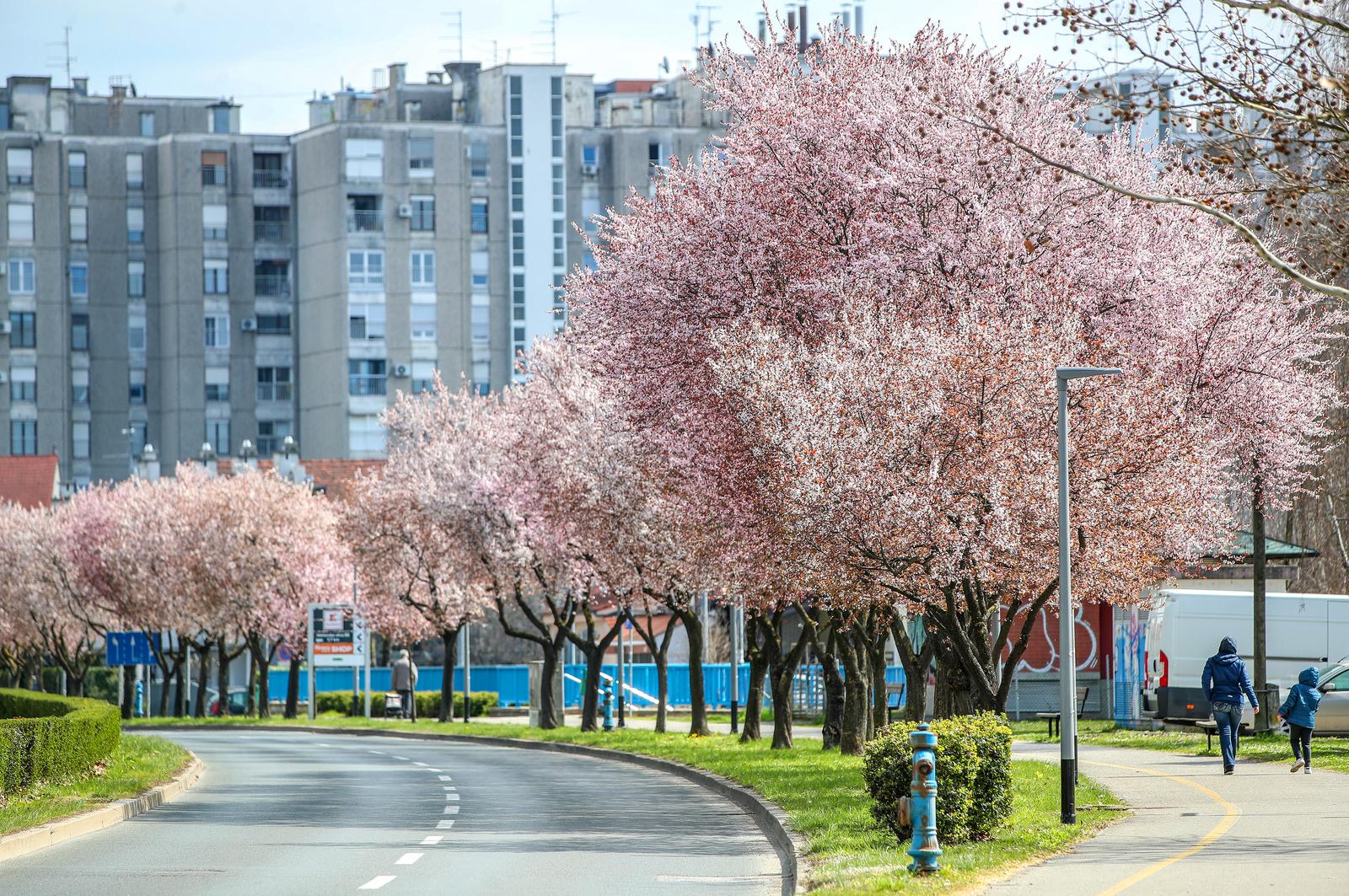
Cherry trees in the district of Prečko, Zagreb. (Photo: Igor Kralj/PIXSELL)
Bonus tip: visit Šulekova street in Zagreb in Spring, which has become famous for its spectacular colors thanks to the blossoming of its cherry trees. Don't forget to go with someone who can take amazing pictures of you for your Instagram!
Plitvice Lakes National Park
It really is impossible not to highlight the national and natural parks of Croatia when talking about a change of season. I do not mention a season in particular because each one offers something magical and different. For example, when we talk about Plitvice Lakes National Park, we cannot compare the four seasons, just enjoy them to the fullest. Autumn's intense red and orange colors beautifully contrast with turquoise lakes, resembling a frame straight out from a fairy tale. Winter covers the park with snow, and the result is a mixture of whites and turquoises that will make your jaw drop. And not to mention the summer, where the green forests also serve as a refuge from the high temperatures with their shade.
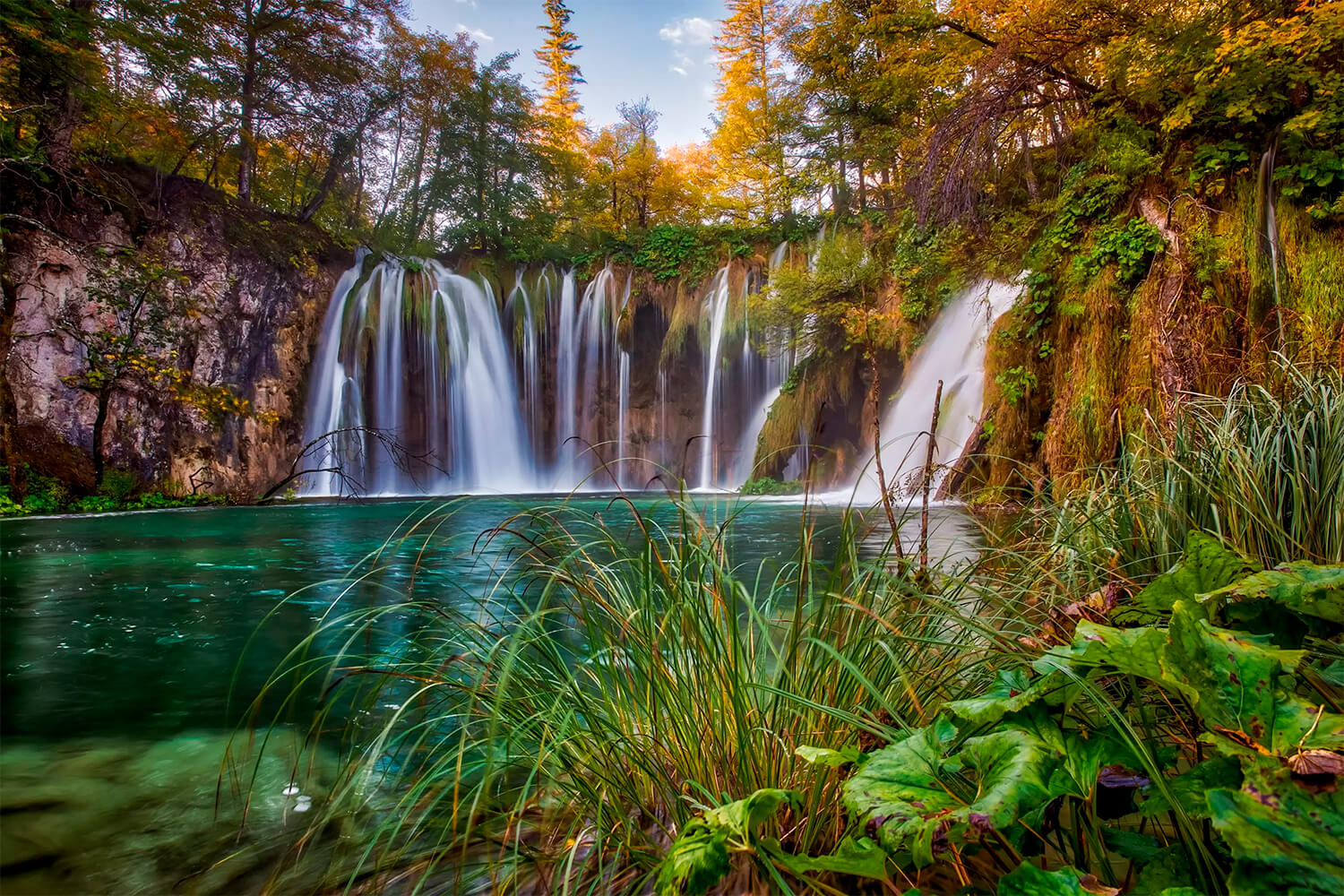
Plitvice Lakes National Park, stunning all year round. (Photo: Vedran Bozičević)
But we all know that, in a place as diverse in flora as the Plitvice Lakes National Park, it is essential to witness its colorful show during spring. It's arguably the perfect time, as it's neither too cold nor too hot to overwhelm you as you wander through the park, and it's one of its most photogenic times of the year!
Find HERE the prices and rates of the tickets to visit the Plitvice Lakes National Park.
Split
We also don't want to overwhelm you with a shower of colors, if that's not your thing. And it is not because Split does not have them, but the experience of spring in the Dalmatian city is lived in a different way. Spring in Croatia comes in different shapes and colors. Although the trees and parks of Split are also beginning to regain their leaves and greenery, the arrival of spring means that the return to the sea and the beaches is getting closer. You will feel that wearing a coat could be unnecessary, with temperatures that can rise up to 17 degrees. Even with the water still relatively cold, some brave souls are already starting to visit the city's beaches to take a dip, realizing that the frequent sunny days and rising temperatures will dry them out quickly once out of the water.
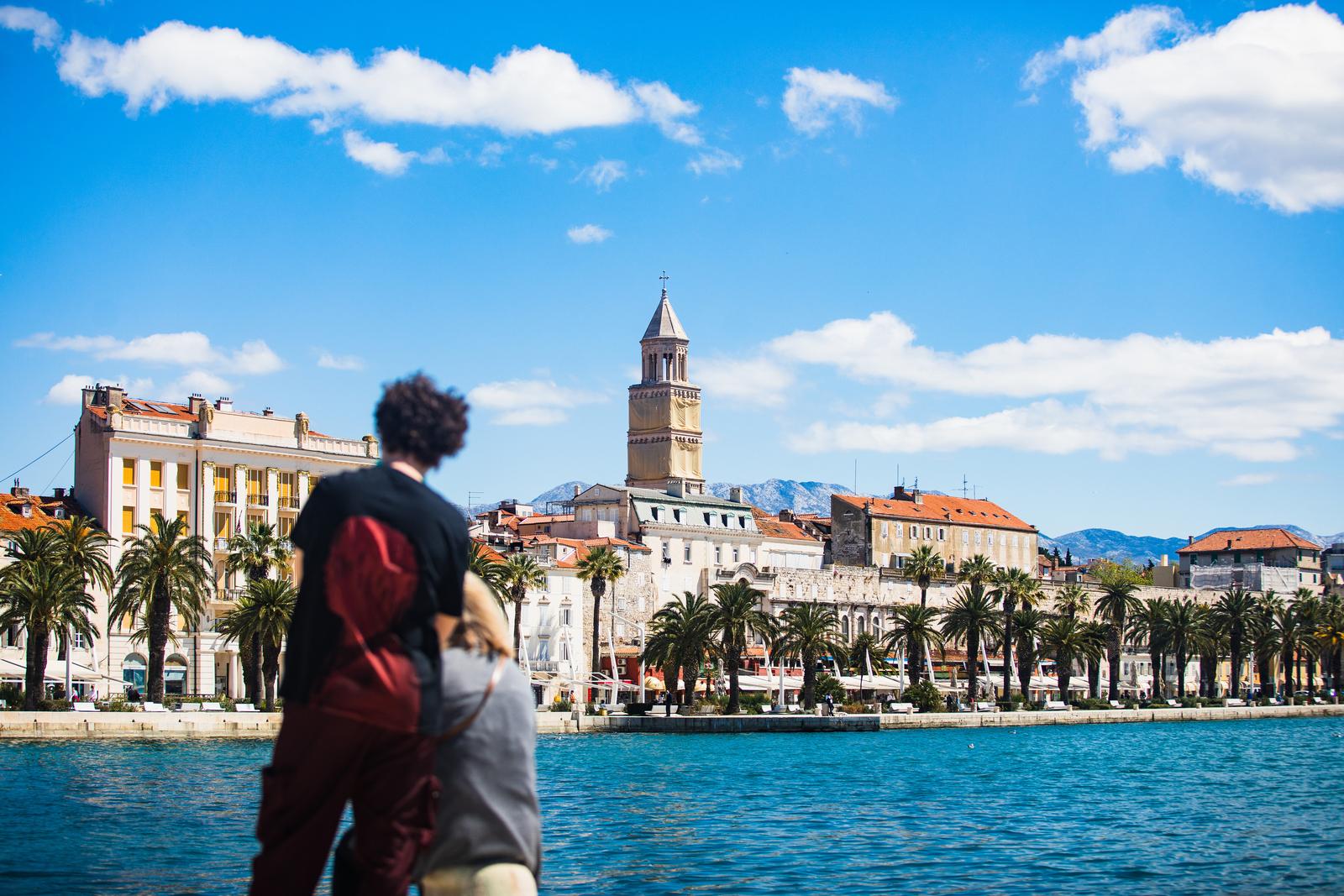
The Diocletian Palace in Split, not during summer, but in April. (Photo: Milan Sabic/PIXSELL)
But without a doubt, the most exciting thing about spring in Split is the progressive reopening of many restaurants, bars, and cafes throughout the season, which have already finished their respective maintenance and are beginning to prepare for the arrival of the busy summer. If you were in Split during the winter, and you will stay here until at least the beginning of summer, you will witness a city that is becoming active every day. Also, ferry lines are starting to increase and you can have the privilege of visiting more islands and destinations without the crowds. And beware, enjoying spring in Split is something that can be replicated throughout the Croatian coast, from Istria to Dubrovnik!
Krka National Park
If you change your mind and would indeed like to see the spring in Croatia blooming at its best, there will always be a national park or nature park near you. The Krka National Park has nothing to envy Plitvice Lakes since its sixteen plunging waterfalls, winding hiking trails, and vast expanse of lush, green forests place it as one of the most visited destinations in the entire country. Krka, apart from being recognized for its spectacular sceneries, is also a very popular destination for adventure lovers. Whether on foot or by bicycle, it is never enough to discover all the wonders that the national park hides. And if you had to pick an ideal time of year to visit, the spring months should be at the top of your list.
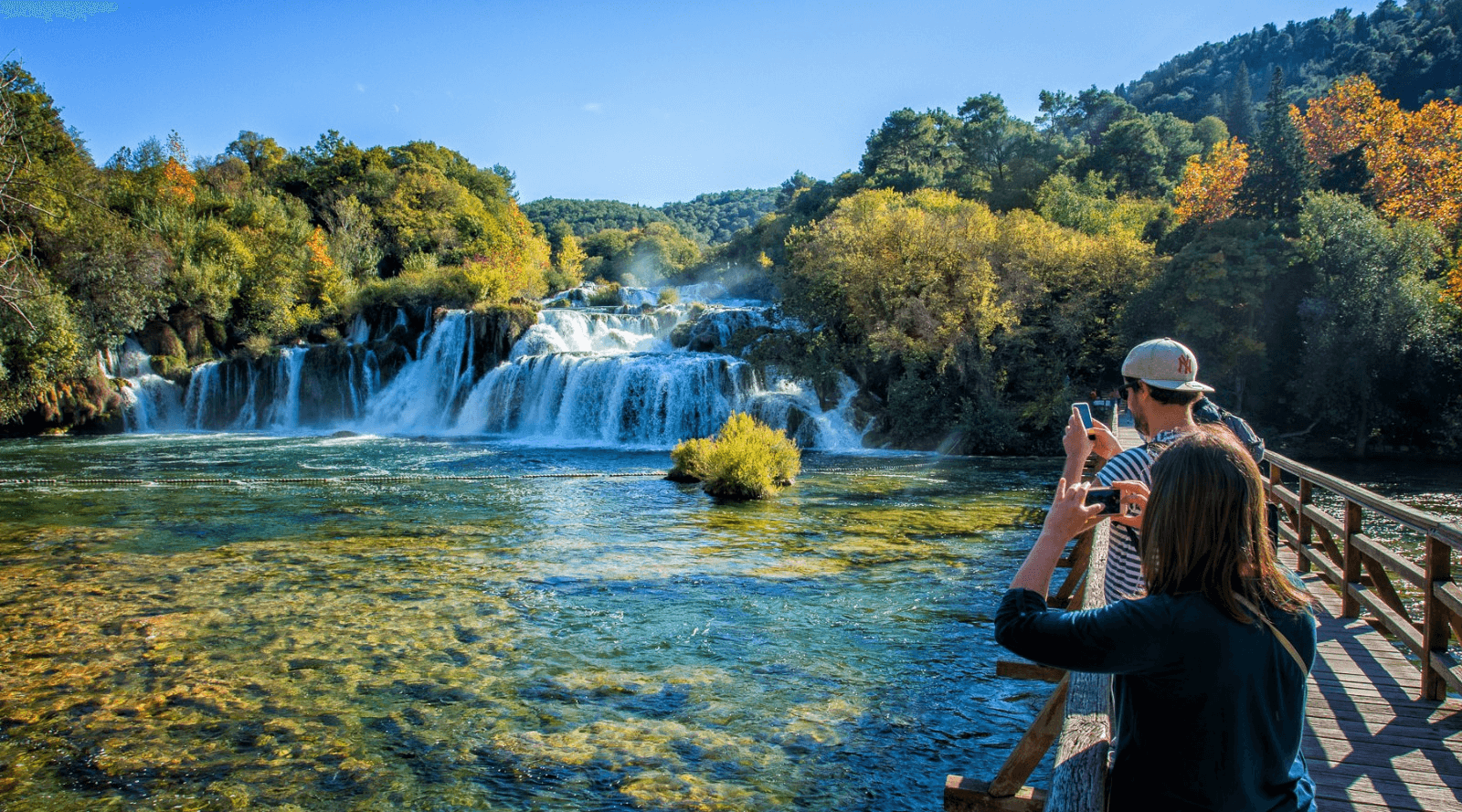
Very close to Šibenik, and less than an hour from Split - Krka National Park. (Credit: Krka National Park)
Although the new measures taken by the National Park, which prohibit visitors from bathing in the falls, have reduced the saturation of people in the main circuit of Krka, summer is still the time of year with the highest volume of tourists. If you are looking to connect better with the nature of Krka, you will surely find it in spring with almost as pleasant weather, colors everywhere, fewer people, and... cheaper prices!
Find HERE the prices and rates of the tickets to visit the Krka National Park.
Osijek
Of course, spring comes everywhere, and not only on the coast and in central Croatia. Moreover, it could be said that spring in eastern Croatia arrives with incomparable intensity. The vast forests, fields, and crops in Slavonia and Baranja are a visual delight both for those viewing it from above with their drones, as well as for those on foot. This part of Croatia is often mistakenly considered a cold, nothing-happening region, but few have the privilege of enjoying its energy and warmth all year round, even in the harshest of winters. And all the more reason, you'll want to check it out for yourself in a season with better weather and full of greenery.
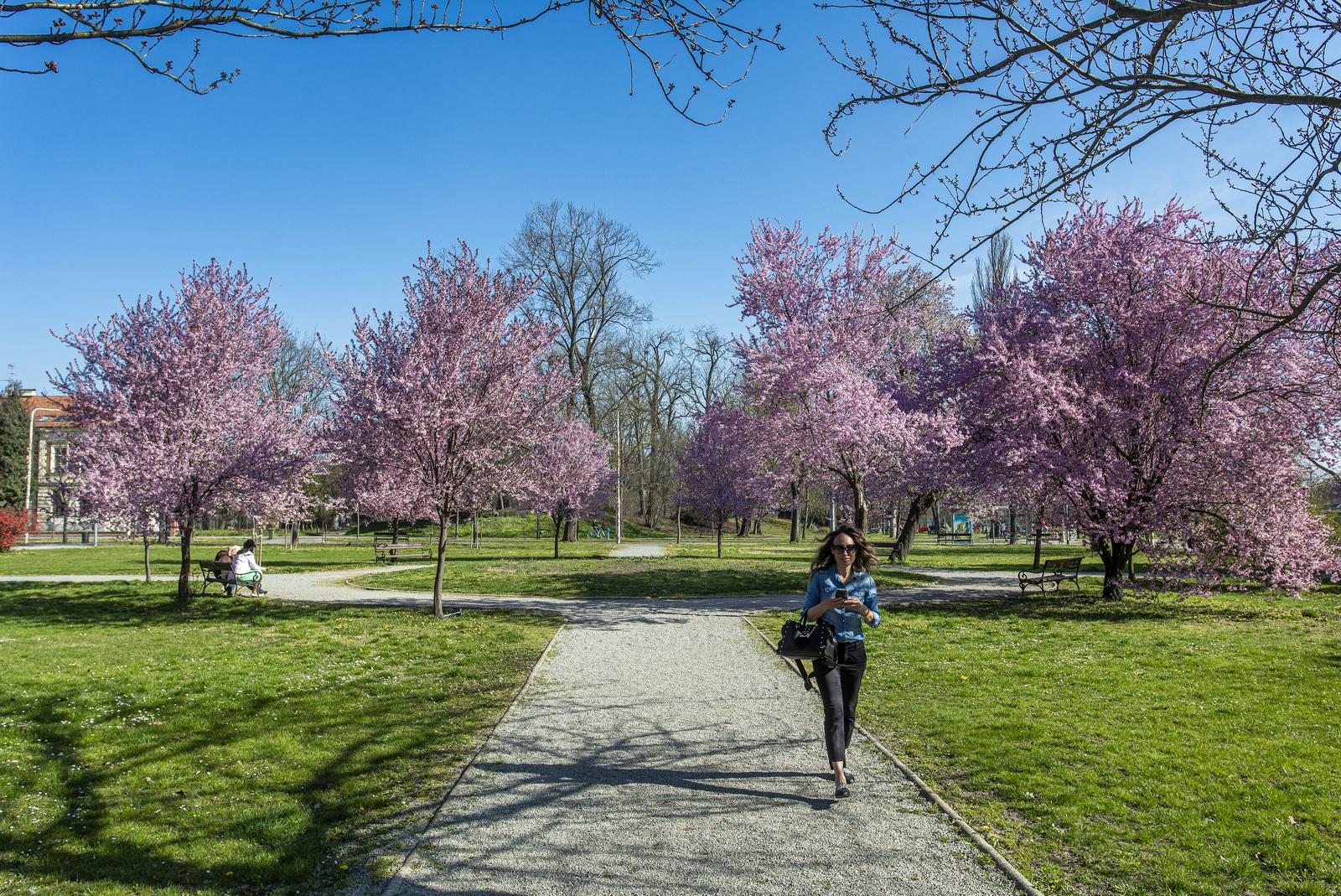
Cherry trees in King Krešimir IV park in Osijek. (Photo: Davor Javorovic/PIXSELL)
There are so many places to visit in this region during spring, but what better place to start than in the largest city in eastern Croatia, and the fourth largest in the country. Osijek is famously known as the greenest city in Croatia, with more parks and public green areas than any other town in Croatia. Wherever you go in Osijek during the spring, you will come across an immeasurable number of trees and gardens full of vibrant colors. Some of the parks that you cannot miss are King Tomislav Park, Sakuntala Park, or King Krešimir IV Park, protected as the first monument of park architecture in Croatia.

Cherry trees in King Krešimir IV park in Osijek. (Photo: Dubravka Petric/PIXSELL)
These are just five examples of places that you cannot miss during spring in Croatia, but believe us when we tell you that the whole country, throughout its territory, has some magic waiting for you during the most colorful season of the year.
For more on travel in Croatia, follow TCN's dedicated page.
Krka National Park to Introduce New Entrance in Šibenik
February 10th, 2022 - The new gateway to Krka National Park will relieve the pressure on two other entrances used by 95% of visitors, and make it easier for tourists in Šibenik to visit the national park
A new entrance to Krka National Park is about to be opened in Šibenik, reports Morski.hr. The Dalmatian town is set to become the sixth official gateway to the magnificent park, a natural karst phenomenon, along with Skradin, Lozovac, Roški Slap/Laškovica, Burnum/Puljane and Kistanje/Manastir Krka.
The overwhelming majority of visitors, about 95%, enter Krka National Park via Lozovac and Skradin entrances, the latter being the closest to the majestic Skradinski buk waterfall. Introducing an entrance in Šibenik is hoped to relieve the pressure on the two mentioned entrances, and distribute visitors evenly throughout all the sites in the park and at the reception centres.
The decision to introduce an official park entrance in Šibenik is a part of the Action plan for visitor management in the period 2019 - 2031, but a strategic project as well.
‘We were of the opinion that this high percentage [of visitors] needs to be more evenly distributed and that a possibility of opening a new entrance to Krka National Park in Šibenik needs to be considered. We proposed the idea of reception and transport of visitors in the city of Šibenik, who spend an average of three days staying in accommodation facilities in town and on islands of the Šibenik archipelago. We also had in mind the citizens of Šibenik to whom the Krka waterfalls are a synonym of the Park and their favourite destination. Naturally, we also thought of new visitors from the two neighbouring counties, who could choose the Šibenik entrance as a jumping off point for their visit to Krka National Park’, said Krka NP director Nella Slavica.
It’s believed that this new concept of visitor reception will help solidify the position of Šibenik on the tourist map and increase the number of visitors to the city, who will then go on to avail of other tourist services in town.
Šibenik Mayor Željko Burić brought up a few steps the City of Šibenik is planning to take to ensure the best possible outcome of their cooperation with NP Krka. ‘A necessary step in the implementation of this project is to introduce regular bus and boat services for visitors, as well as a commercial space for presentation of the Public Institution "Krka National Park" in Šibenik', said Burić.
Krka National Park is 37! You're All Invited to Breathtaking Birthday Party
January 21, 2022 – Celebrating its birthday this week, Krka National Park is 37 years old. To mark the occasion, the park is inviting everyone to visit this weekend for free.
Just 20 minutes drive from the seaside town of Šibenik, Krka National Park is one of Croatia's most famous, most popular and most spectacular National Parks. Within 109 square kilometres of the Krka river valley, you'll find seven spectacular waterfalls, wonderful wildlife, epic karst rock canyons and thrilling views. It is a recreational playground of limitless enjoyment.
 © Krka National Park
© Krka National Park
Over one million visitors come each year to Krka National Park. On the birthday weekend that Krka National Park is 37, park authorities are opening the entrances to everyone for free. It's the perfect opportunity to come and explore. From hiking trails and cycle paths to bird watching and landscape or nature photography, there's lots to see and do.
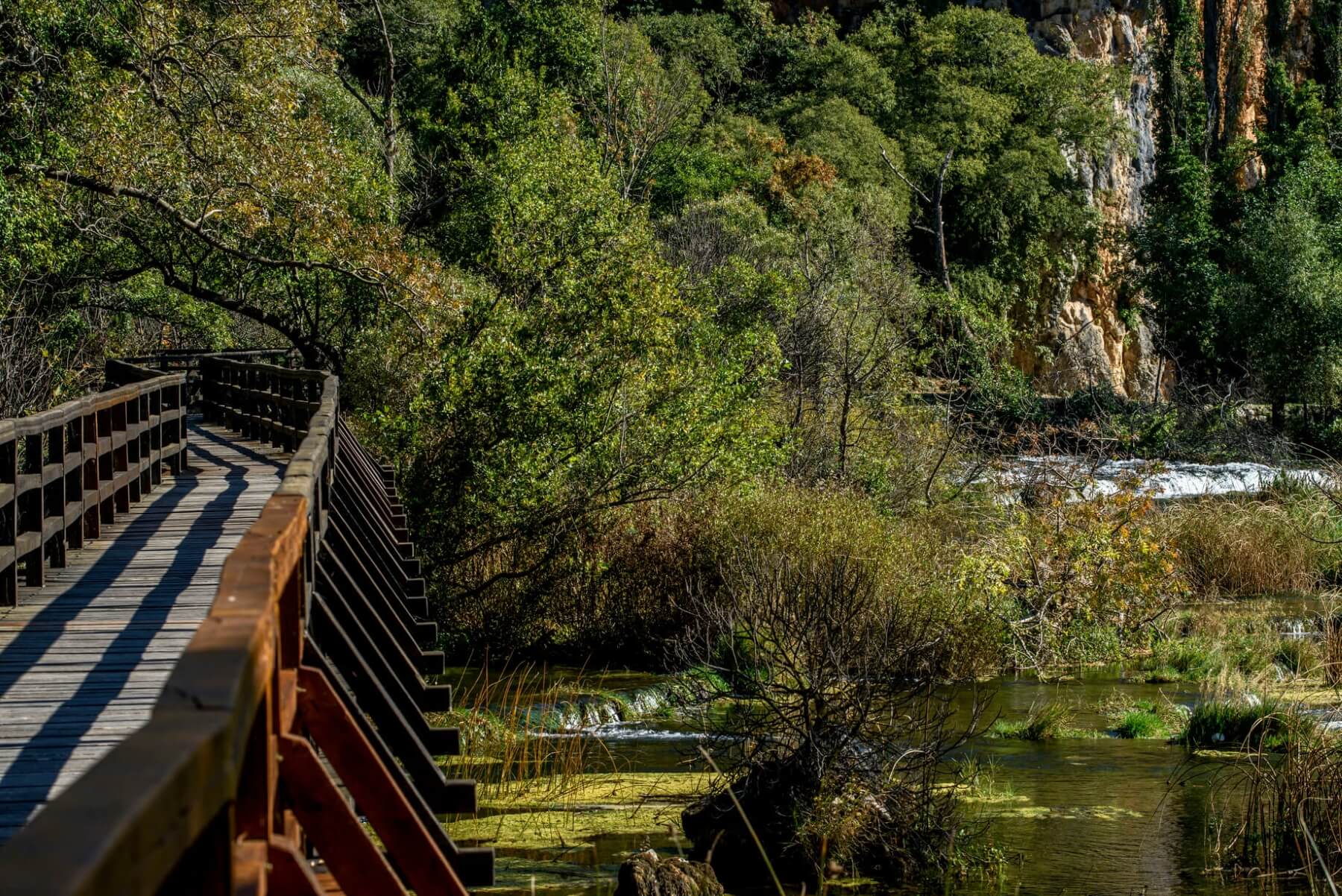 Roški Slap waterfall near Drniš © Krka National Park
Roški Slap waterfall near Drniš © Krka National Park
You may have seen Skradinski Buk and the pools near the southern section of the park and Šibenik. But, have you found Roški Slap waterfall further up, just a few kilometres west of Drniš? Or did you see the northern entrance of the park and its series of waterfalls near Knin? There's more in Krka National Park than you could discover in just one weekend.
'People from the Krka' photography for Krka National Park is 37

An extra attraction added in time for the birthday weekend is a public display of a specially curated photo series.
The landscape of what is today Krka National Park has been marked for millennia by the hands of man. People have existed alongside the Krka river since prehistory. Within the park, you can see evidence of how people have lived here across the ages.
People from the Krka is an exhibition of photographs that show folks whose lives and work happen within the river Krka canyon. The photographs are taken in the period from the founding of Krka National Park until today. The exhibition has been authored by renowned photographer Damil Kalogjera, who is particularly noted for his portrait work. It is the first in a series of NP Krka exhibitions that will present the people who live along the Krka.
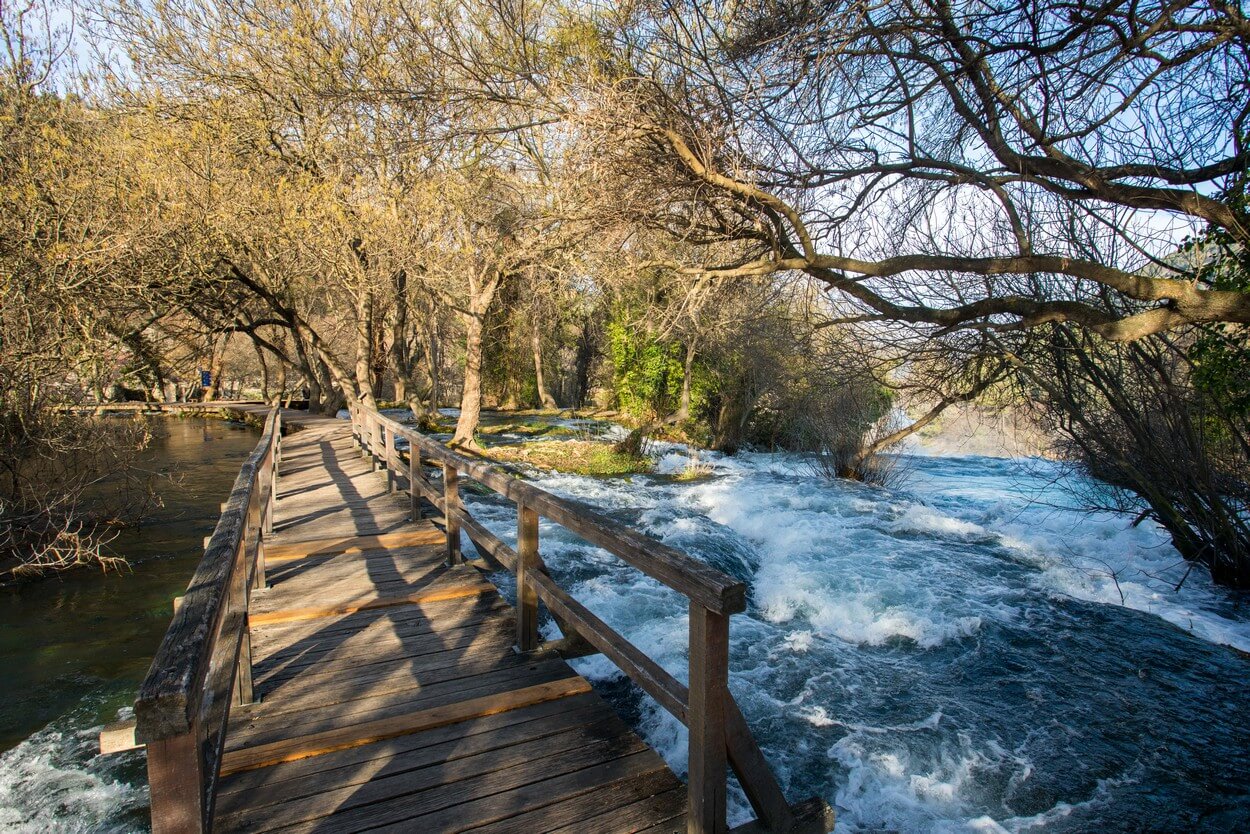 © Krka National Park
© Krka National Park
The opening of the photo exhibition will take place at 12 midday on Saturday 22 January at the Imperial Plateau on the lookout point above Skradinski Buk. It offers an unforgettable view of Krka's largest and most famous waterfall. Performing at the opening ceremony will be Skradin acapella group Klapa Skradinski Buk.
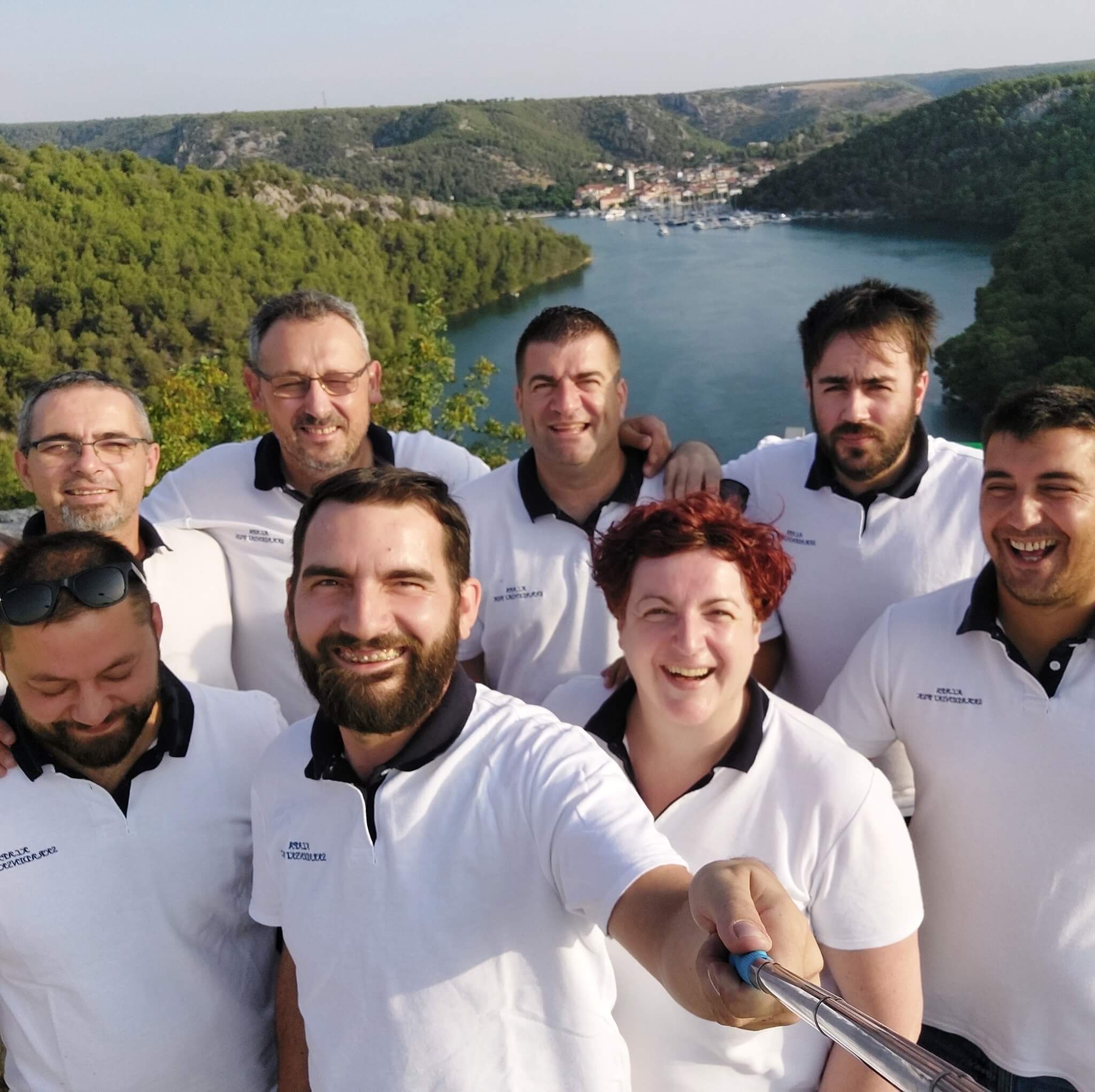 Klapa Skradinski buk
Klapa Skradinski buk
On the weekend that Krka National Park is 37, admission to the park is free on Saturday and Sunday. The park is open from 9am to 4pm. Entry into enclosed spaces is only possible with an EU digital COVID certificate.
Why not take advantage of the offer and visit Krka National Park for a full weekend? You can find brilliant accommodation in nearby Šibenik (here), Knin (here) or Drniš (here).
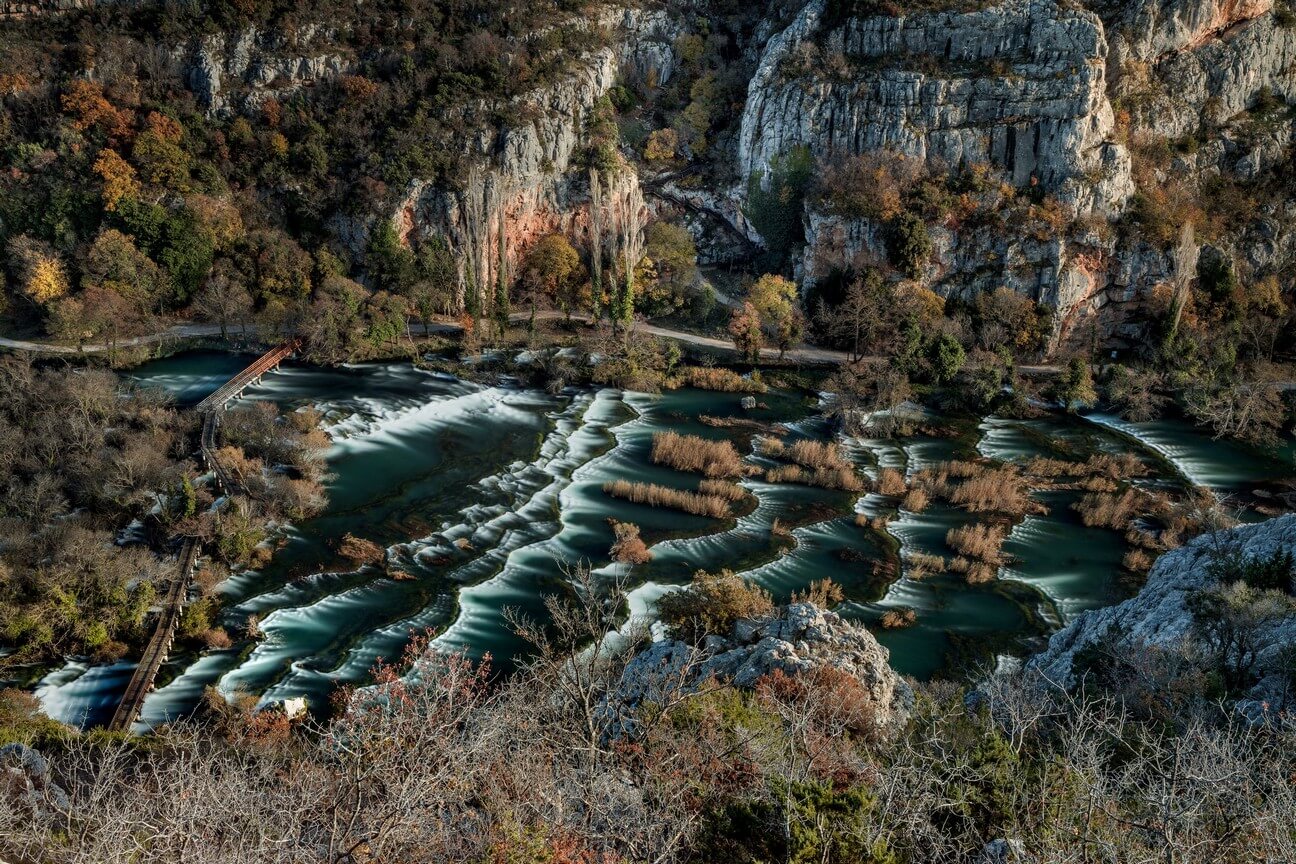 Roški Slap waterfall near Drniš © Krka National Park
Roški Slap waterfall near Drniš © Krka National Park
For more information about Krka National Park, look here.
Krka National Park Offers Promotional Entrance Fee Until October 31st
October 26, 2021 - As it joins the promotional campaign of Croatian Tourism Month, Krka National Park offers a special ticket price for all its attractions, which will be valid from October 25th to 31st.
With a special ticket price for all land sites in the Park of 65 kn for adults and 52 kn for children aged seven to eighteen, which will be valid from 25 to 31 October, Krka National Park offers an interesting discount and thus joins the promotional campaign Croatian Tourism Month, which is carried out by Ministry of Tourism and Sports and the Croatian National Tourist Board, reports Turističke Priče. For children up to the age of seven, entry to the Krka National Park has always been free.
The aim of the action is to encourage the citizens of the Republic of Croatia to get to know and visit different parts of our country at better prices for many tourist services and products, from the accommodation, transport, and sightseeing to catering services and various experiences, with the aim of encouraging domestic tourism and increasing tourist traffic. in the off-season.
Every season on the Krka is special for some reason. Painted with autumn colors, Krka provides a real experience: pleasant temperatures, the liveliness of flora and fauna, plenty of water, pronounced geomorphological forms of rocks, and travertine. In addition, the enjoyment of mastering the educational hiking trails and cycling routes will make the visit unforgettable. Krka National Park includes the largest and most beautiful part of the Krka River and the lower course of the Čikola River. The basic phenomenon of the Krka National Park is tufa, which, along the entire course of the river, has formed seven enchanting travertine waterfalls. The most famous and most visited waterfall, Skradinski buk, is the longest travertine barrier in Europe.
The Skradinski buk and Roški slap sites are open for visitors from 9 am to 5 pm in October, and the upstream sites from 10 am to 5 pm, the Krka National Park reported.
Krka National Park is an absolute gem, with a range of fantastic things to see and do for all the family. In partnership with Krka National Park, we are delighted to present the first TC video guide below.
Check our full guide on all Croatian National and Nature Parks HERE.
For more on travel in Croatia, follow TCN's dedicated page.
PHOTOS: Beautiful Locations of Active Šibenik's Sports and Recreation
September 22, 2021 – From cycling and kayaking to hiking and an epic zip line, see the fantastic natural landscape that holds active Šibenik's thrilling offer.
When temperatures ease off, the Croatian coast welcomes a whole different type of guest. Spring, Autumn and Winter is the favourite time for sports enthusiasts and fitness fans to visit. And, few places on the Mediterranean have an offer complete like active Šibenik.
Outside of the peak season, the stunning nature that surrounds Šibenik is free from the bustle of visitors. Cyclists and runners speed by unobstructed. Maybe they'll pass a couple of hikers enjoying the same trails and spectacular views?
 St Anthony's channel, St Nicholas Fortress and the cycle and walking path that reaches it via an island © Šibenik Tourist Board
St Anthony's channel, St Nicholas Fortress and the cycle and walking path that reaches it via an island © Šibenik Tourist Board
In the evenings, during their rest time, active Šibenik's guests have the city's best hotels, restaurants and charming Old Town almost to themselves. They share the cafe, bar and restaurant terraces only with Šibenik residents, relaxing once more now the city is returned to them.
Key to Šibenik's year-round appeal for fitness and sport fans is the city's unique landscape. No place in Croatia has natural assets like Šibenik. It is surrounded on all sides by a remarkable and startlingly varied topography.
Firstly, between Šibenik city harbour and the open Adriatic is a long waterway – St. Anthony's Channel. It is bordered on either side by two huge stretches of wild nature. Then, at the rear of the town, elevated up from sea level and next to Barone Fortress, the area of Šubićevac. Here, the entrance to the vast Šubićevac Forest Park, much of it an untamed, natural landscape. Thirdly, the vast Krka National Park, which lies just 10 kilometres north-east of Šibenik
Active Šibenik: St Anthony's Channel

An epic 2000 metre long waterway, St Anthony's Channel is both a gateway to the open sea and the entrance to the city for anyone sailing into Šibenik. It is 140 – 220 metres wide and is bordered on each side by near untouched Dalmatian nature. On one side, sheer cliffs for one wall of the channel. At the top, dense pine forests, walking, hiking and cycling trails. Also, the famous recreation site of Martinska.

On the opposite side of the channel, a very different layout of the land. Here, the pines are much lower and closer to the channel. Between the two, idyllic beaches - the best in Šibenik – line a pathway designated for running, walking and cycling. Those on bicycles drop down from small hills on the interior. After following the path at the side of the water, their ultimate reward is the spectacular St Nicholas' Fortress. On both sides of St Anthony's Channel you'll see incredible views of Šibenik, its harbour and the side opposite.

For those who prefer recreation on the water, St Anthony's Channel is perfect to explore by kayak. It's also one of the easiest ways to discover all of Šibenik's best beaches. Sticking close to the pine-sheltered coast, beautiful sailboats pass you in the centre of the channel, on their way to or from the city.
Active Šibenik: Šubićevac Forest Park
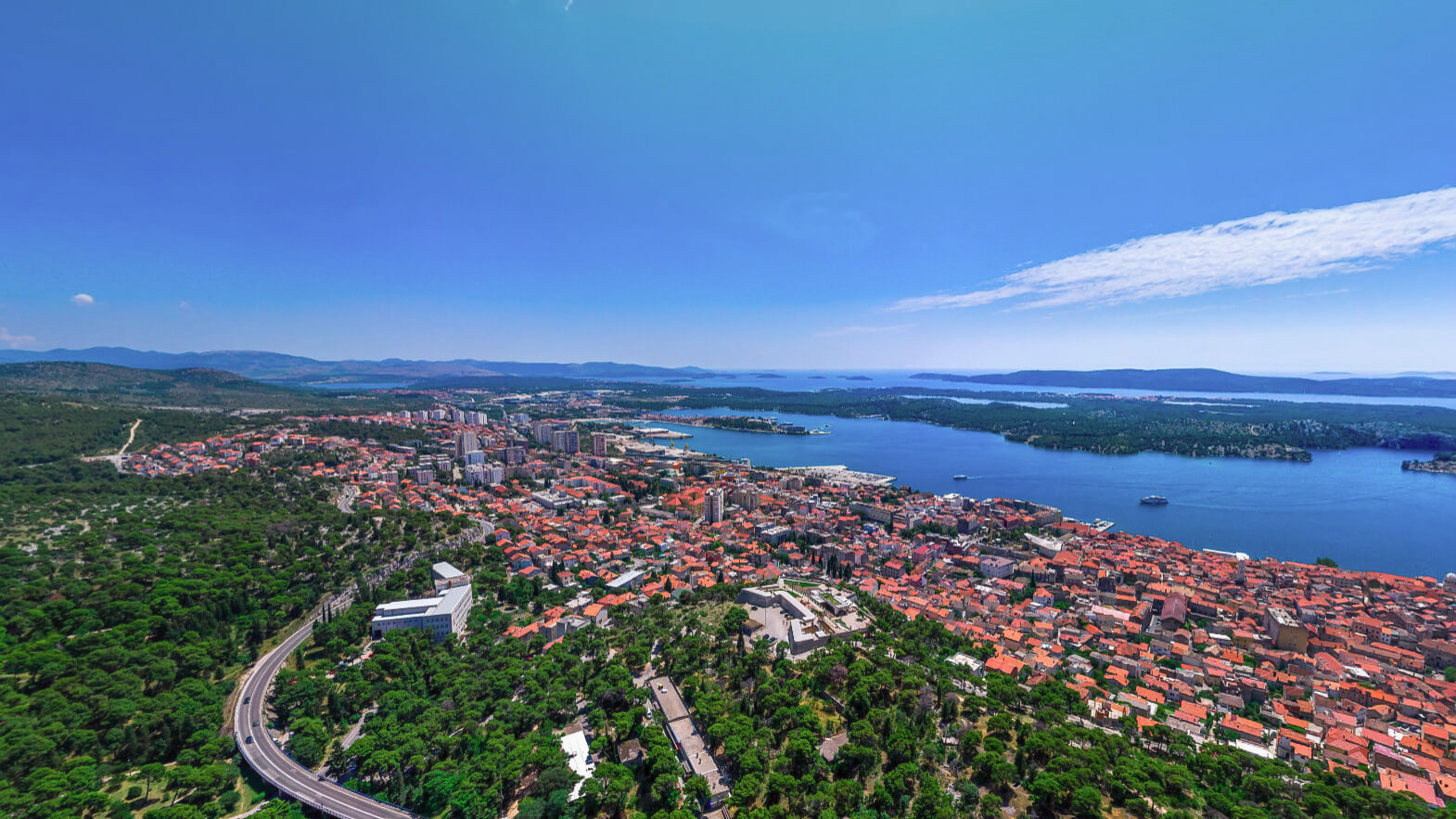 View over Šibenik, with Šubićevac Forest Park at the rear of the city © Šibenik Tourist Board
View over Šibenik, with Šubićevac Forest Park at the rear of the city © Šibenik Tourist Board
To visitors, Šubićevac Forest Park is the least famous of all Šibenik's recreational areas. A huge stretch of forestland, much loved by city residents, it rises above the city near Barone Fortress. The section of forest closest to the Šubićevac is designated as a city park. Within this part, you'll find a children's playground, specially designed to be accessible to all, including children with special needs.
 Easily accessible section of Šubićevac Forest Park © Javna ustanova Športski objekti Šibenik
Easily accessible section of Šubićevac Forest Park © Javna ustanova Športski objekti Šibenik
Throughout this section, designated paths for cycling and walking. Running to the southeast, a much larger area of near untouched forest. Here, a wilderness ripe for runners or hikers to explore. It's worth seeking out the tiny Church of St Michael here.
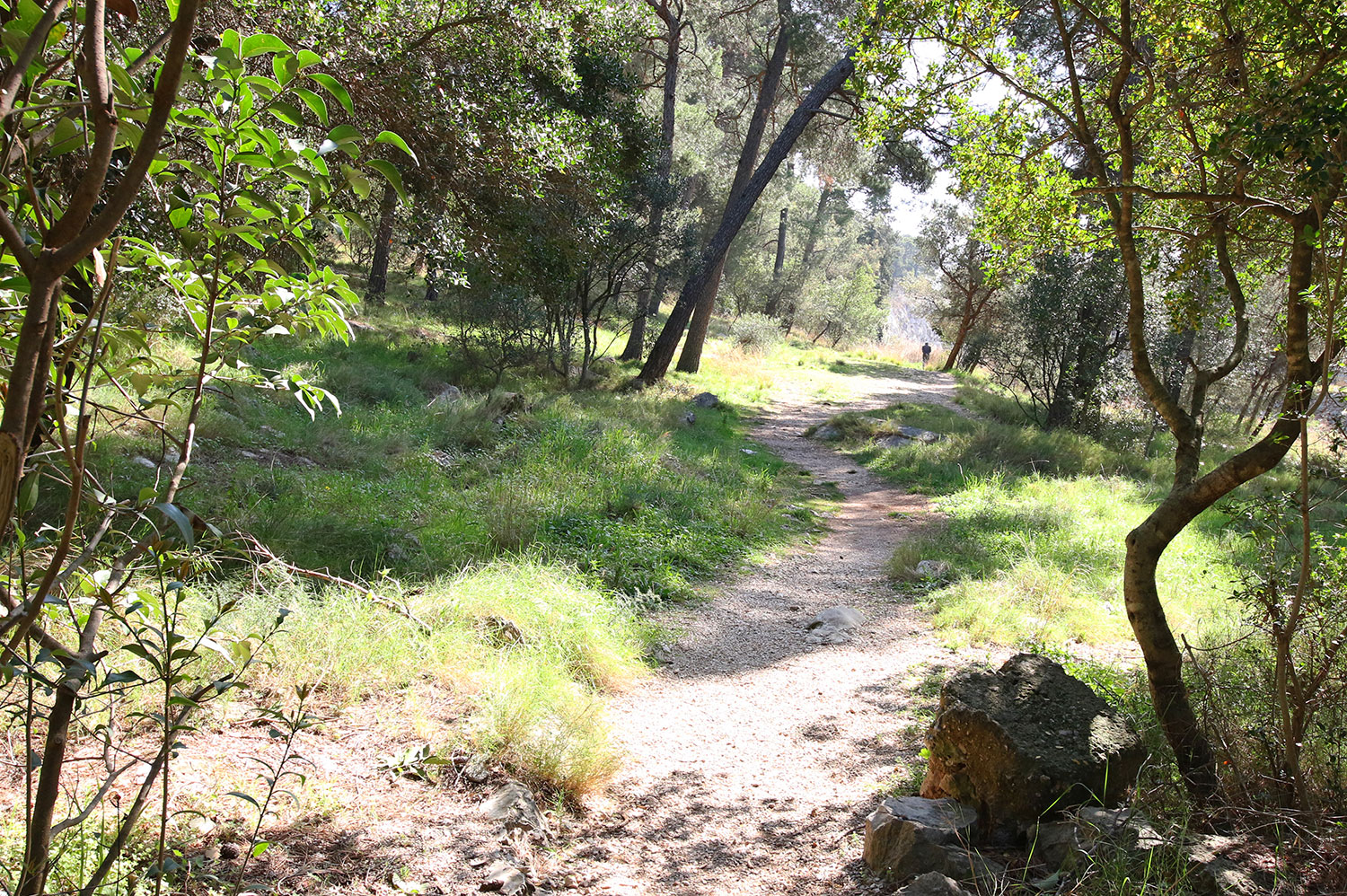 Paths through forest wilderness © Javna ustanova Športski objekti Šibenik
Paths through forest wilderness © Javna ustanova Športski objekti Šibenik
Residents say the very best views of Šibenik come from Šubićevac Forest Park. Certainly, they are breathtaking.
 The best views over the city? It's a tough one to call - Šibenik has many contenders © Javna ustanova Športski objekti Šibenik
The best views over the city? It's a tough one to call - Šibenik has many contenders © Javna ustanova Športski objekti Šibenik
Active Šibenik: Krka National Park
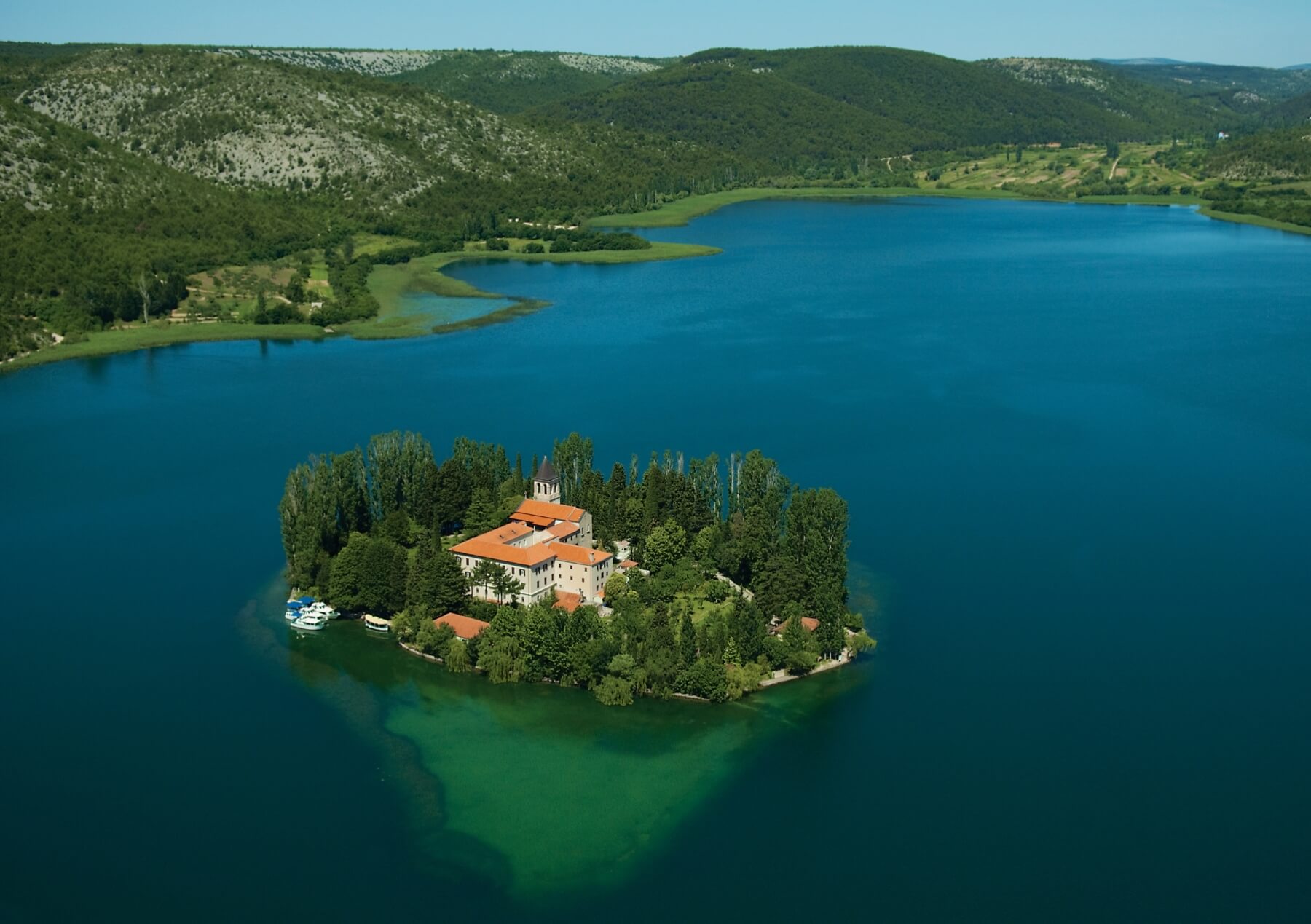 Island in Krka National Park © Šibenik Tourist Board
Island in Krka National Park © Šibenik Tourist Board
A series of wide pools, fed by cascading waterfalls, Krka is one of Croatia’s best known and most spectacular National Parks. Famous water features like the unforgettable Skradinski Buk dominate the park's postcard images. You'll find it near the park's most southerly entrance, very close to Šibenik. But, beyond this eye-catching introduction lies a further 109 square kilometers of spectacular National Park to discover. The best way to experience it is by walking, hiking or cycling.
 Countless captivating viewpoints © Krka National Park
Countless captivating viewpoints © Krka National Park
Hiking and walking trails of Krka National Park
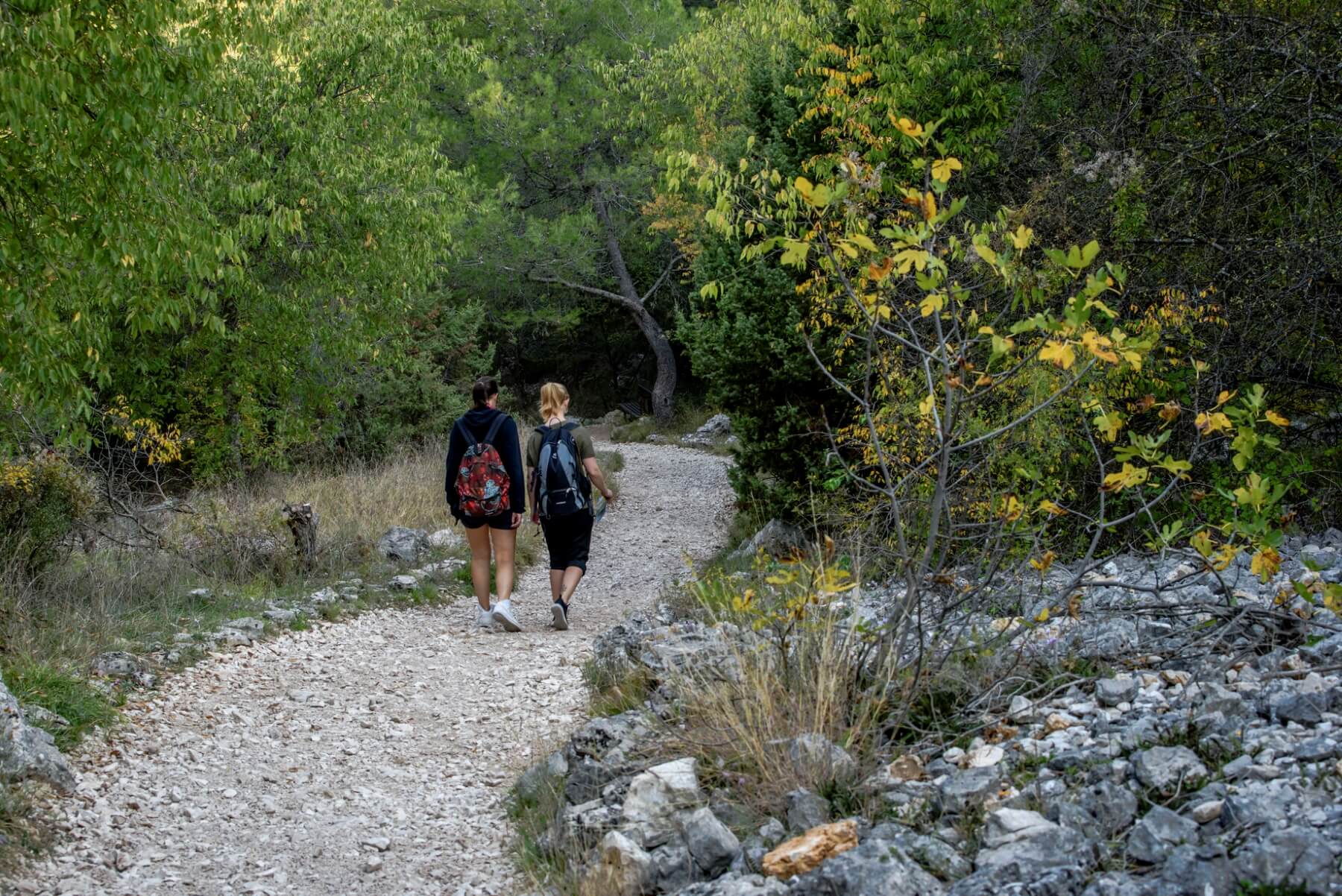 Walking and hiking trails © Krka National Park
Walking and hiking trails © Krka National Park
The park's hiking and walking trails give you the most thrilling views of this epic landscape and its wealth of flora and fauna. At the side of the trails, educational panels detailing the plants and animals you pass.
 Epic landscape © Krka National Park
Epic landscape © Krka National Park
There are three circular trails: Skradinski buk (1900 m), Roški Slap (1360 m) and Krka Monastery (2100 m). A walking/cycling trail also leads to Skradinski buk from the Skradin bridge (3400 m), while from Lozovac, it is possible to take a forest trail (875 m) down to the park's longest waterfall.
 Walking over waterfalls © Krka National Park
Walking over waterfalls © Krka National Park
The shortest trail is 300 m long and leads to Bilušića buk, while the longest trail is Stinice-Roški slap-Oziđana pećina and covers 8.5 kilometres. In total, there are 7 spectacular waterfalls to find as the river Krka descends through the park.
Cycling routes of Krka National Park
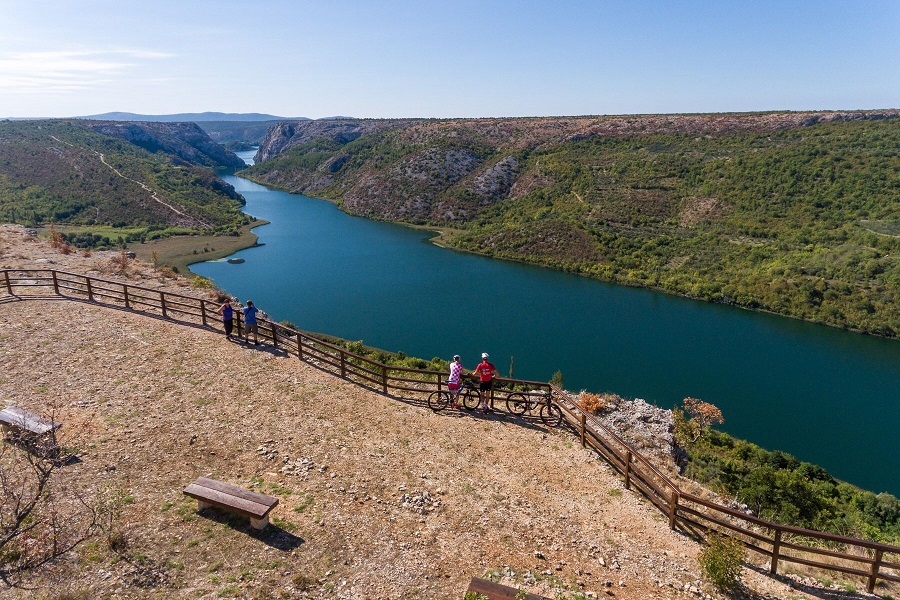 Breathtaking views on the cycling and walking routes © Krka National Park
Breathtaking views on the cycling and walking routes © Krka National Park
Bicycling through Krka National Park is a journey of endless enjoyment. If your perfect cycling route offers stunning landscapes, then this is the place for you. But, if you're curious to learn about the park's cultural and historical heritage, then cycling also helps you unlock these park secrets.
 Cycling © Krka National Park
Cycling © Krka National Park
No less than fourteen cycling routes crisscross the park. They are divided into three types:
Road route - perfect for racing bikes and dedicated cyclists
Trekking & family route - a mixture of paved roads and gravel paths, perfect for city bikes, mountain bikes, families with children and cyclists of any age and ability.
Mountain biking route – a mixture of gravel paths and unarranged forest paths, with sharp ascents and descents, designed for mountain bike enthusiasts in good physical condition and with advanced cycling skills.
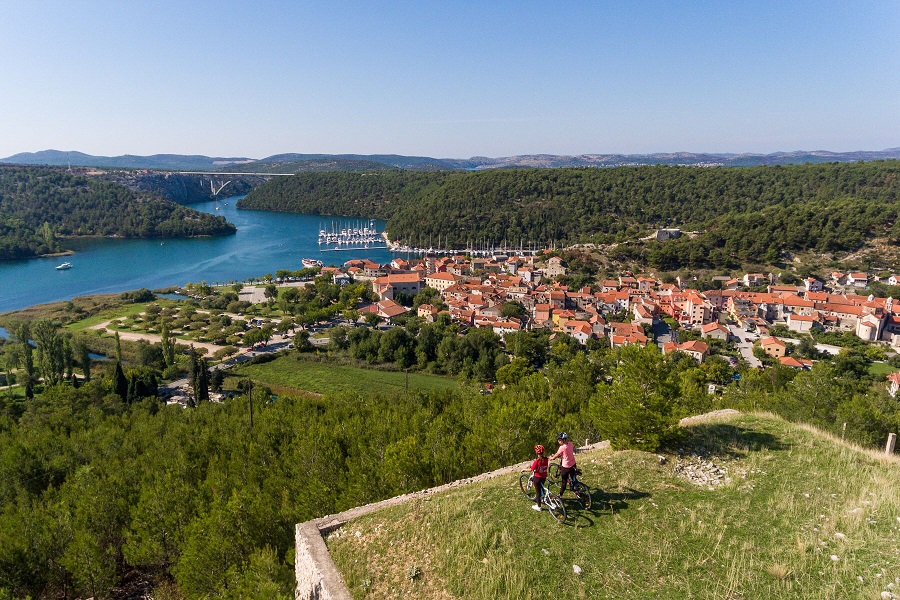 Cycling above Skradin © Krka National Park
Cycling above Skradin © Krka National Park
Šibenik zipline
On the northeast corner of the park, stretching across an epic canyon, one of Croatia's most thrilling ziplines. Flying from cliffs hundreds of metres above, so vast is the canyon that you can barely see the thrillseekers at the end of the first line. And, after that, there are still another two to go!
For more information and/or booking any of these activities, visit/contact Šibenik Tourist Board here
For more on great things to do in Šibenik, be sure to check Total Croatia News's dedicated pages here
Skradinski Buk Pond Turtles Return after Long Absence from Krka National Park
September 19, 2021 - Skradinski buk pond turtles have returned to their ideal living conditions in Krka National Park, primarily thanks to fewer visitors caused by the pandemic.
After a long absence, the strictly protected pond turtle species (Emys orbicularis) has found a haven at the foot of Europe's longest travertine barrier. An adult and two young individuals have been confirmed, reports Sibenik.in.
The pond turtle has ideal living conditions in Krka National Park. It is most numerous in the middle and upper course of the Krka river, especially along the banks near the Krka monastery: the marsh at the foot Carigradska draga is its essential habitat. Thanks to the reduction in the number of visitors caused by the pandemic, the pond turtle returned to the area of Skradinski Buk after many years. The swimming ban in Skradinski Buk has further reduced the pressure on the aquatic ecosystem, so this year they lay eggs. The natural habitats of pond turtles are stagnant and slow-flowing freshwater rich in vegetation, such as muddy-bottomed lakes, ponds, rivers, canals, floodplain forests, and brackish waters. Since it is a cold-blooded animal, it is suitable for quiet places to sunbathe, mostly on stumps and rocks.
The pond turtle is a strictly protected species: protected by the Nature Protection Act, the European Union Directive on the Protection of Natural Habitats and Wild Fauna and Flora (Habitats Directive), and the Convention on the Conservation of European Wildlife and Natural Habitats (Bern Convention). Furthermore, Emys orbicularis is the target species of the ecological network Natura 2000, a conservation area important for species and habitat types HR2000918 Krka and the surrounding plateau. The name Emys comes from the Greek word "emys" (ὲμύς), which means "freshwater turtle".
The pond turtle is also active at night when it hunts and searches the surroundings but never moves away from the water. It feeds mainly on invertebrates, most often beetles, snails, shrimp, earthworms, and tadpoles, less often on amphibians and smaller fish, and least on aquatic plants. It has a hard shell, more flattened than a land turtle and slightly wider at the back. In populations in the Mediterranean, the shell is about fifteen centimeters long. It has five well-visible toes with claws on its front legs and four on its hind legs.
Males and females are easily recognizable, primarily by size: females are larger than males. As the animal grows, so do the plates that cover the carapace (upper) and plastron (lower part of the shell). They form growth zones, with which the age of the individual can be determined by counting the rings. Like rings on a tree, they grow in concentric rings spreading from one corner. Growth largely depends on the climatic conditions where the turtle lives, so it is slowed down in winter or during the dry season. In the unfavorable season for growth, certain parts of the rings tear and darken, and in the good season, they expand. Other factors that affect growth rate are sex, habitat characteristics, diet type, and food availability.
The pond turtle chooses land-laying areas with sandy surfaces rich in necessary food and safe from predators. They have the so-called temperature-dependent determination of embryonic sex: eggs incubated at temperatures below 25° C only males will develop, and those incubated above 30° C only females will develop. The ratio of males to females due to different natural conditions during the day and night is generally 50:50. Pond turtles reach sexual maturity from 6 to 8 when they grow to a length of about 12.5 cm. They are then considered fully developed adult individuals. Their development is sensitive and depends on ecological, genetic factors, food availability, and habitat quality. The oldest record of the presence of a pond turtle in "Kerka" at "Scardone" dates from 1780 (in the work of Pietro Nutrizi Chrisogon Notizie per servire alla storia naturale della Dalmazia).
For more, follow our lifestyle section.
Meet Krka National Park, the Total Croatia Video Guide
September 16, 2021 - It is arguably the most beautiful - and certainly the most diverse - of Croatia's national parks. In the first in a new series from our sister site, Total Croatia, meet Krka National Park, the video guide.
One of my favourite facts about Croatia is that over 10% of its territory is given over to national and nature parks (you can get an overview of all 20 parks here). Add to that over 1,700 kilometres of Adriatic coastline in addition to more than 1,000 islands, and it is not hard to understand why many consider Croatia to be the most beautiful country in Europe.
But while the majority of the parks focus almost entirely on their idyllic nature, Krka National Park offers an incredibly diverse experience. There are so many things to do here beyond the famous waterfalls and boat trip to Visovac monastery. Things that many tourists often don't find out about until it is too late.
With an impressive 1.3 million tourists a year in normal times, and a short day trip from the likes of Split, Sibenik and Zadar, Krka National Park is an excellent day out for all the family. And with so much on offer, we thought it would make the ideal starting point for a new TC video series, providing guides to some of Croatia's top destinations.
The waterfalls of Krka National Park are internationally famous, but did you also know about the Roman military amphitheatre at Burnum, the six Croatian fortresses guarding strategic points of the mighty River Krka, the educational workshops showcasing traditional life in Dalmatia as it once was? Or the 388 km of cycling trails, numerous hiking trails, an Orthodox monastery with Roman catacombs, and even a Neolithic cave documenting signs of human life at Krka, dating back to 6,000 BC.
Krka National Park is an absolute gem, with a range of fantastic things to see and do for all the family. In partnership with Krka National Park, we are deligthed to present the first TC video guide below.
For more information about Krka National Park, visit the official website.
For more information about tourist destinations in Croatia, check out the new Total Croatia portal.
(with thanks to Jose Alfonso Cussianovich for the video editing)
Interesting Legends Behind 4 Popular Tourist Destinations in Croatia
July 28, 2021 - Croatia is mostly visited by tourists because of its long Adriatic coast but it's also blessed with enchanting rivers, lakes, and waterfalls. Not many visitors know that the surreal crystal clear blue and emerald colors of Croatia's different bodies of water are also home to many mysterious mythical creatures, historical heroines, and legendary tales. Get to know the mythical inhabitants of Croatia and explore the world of epic Croatian folklores in 4 popular tourist destinations in Croatia.
Cetina and the Story of Mila
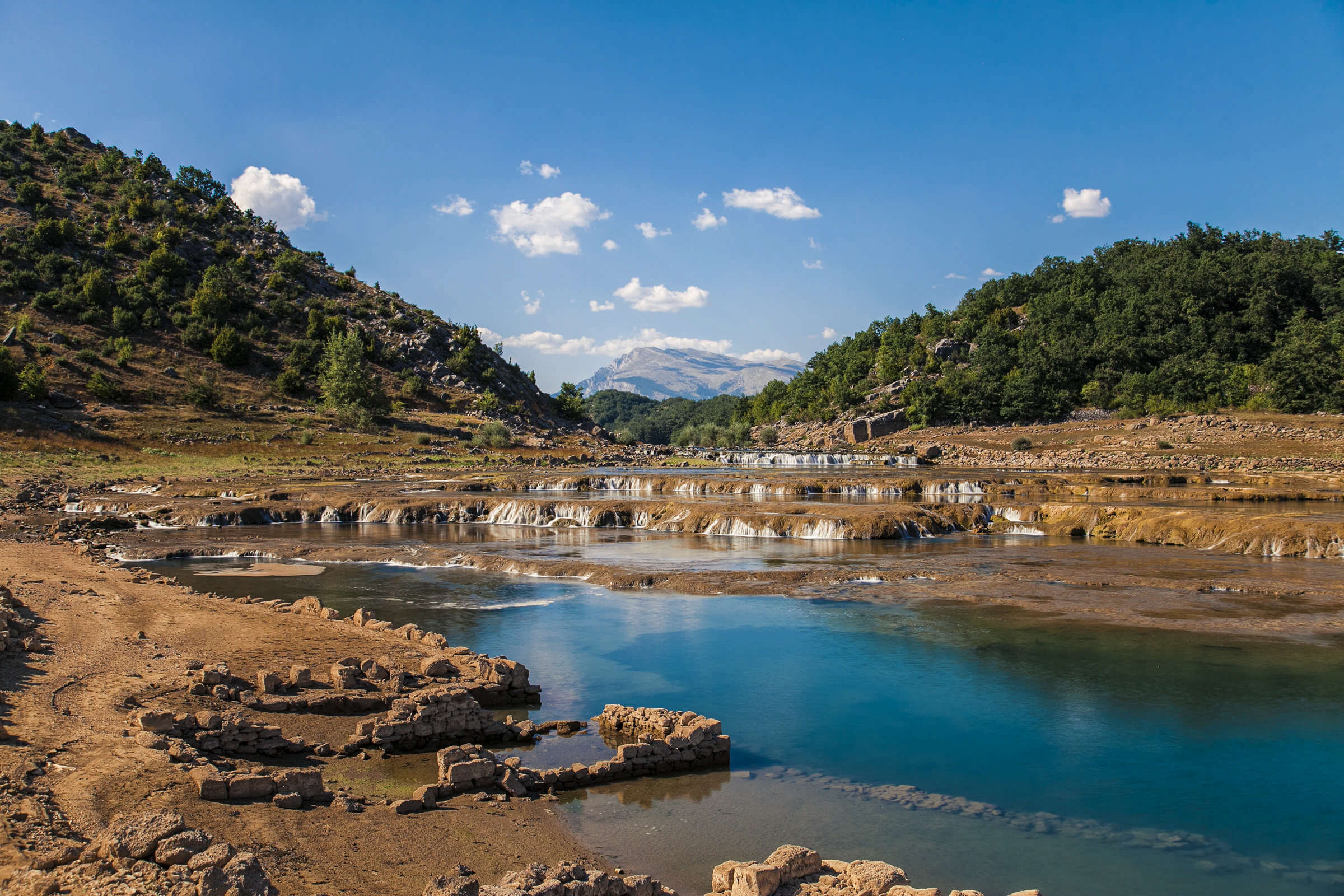 Photo credit: Mario Romulić
Photo credit: Mario Romulić
Gushing under two mountains, the Dinara and Gnjat, and passing through the scenic towns of Sinj, Trilj, Zadvarje, and Omiš where it finally meets the Adriatic Sea, the Cetina River is one of the most beautiful canyons in Croatia and is a famous day trip destination for both locals and tourists. Considered the longest river in Dalmatia with its length of 101km, Cetina is a perfect place for canyoning, zip-lining, freshwater kayaking, and white water rafting. The clear blue water of the Cetina River has been a generous source of clean water and freshwater fish for the people of Dalmatia over the centuries. Thanks to the nymph named Cetina, this beautiful river came to life. According to legend, Cetina desperately dreamed of conceiving a child and was tricked by the sexually ravenous God, Zeus, who promised to bore her an offspring after their union. After many weeks of waiting, Cetina did not get pregnant and upon realizing Zeus' trickery, the heartbroken nymph wept endlessly until her tears formed a river and eventually, the Cetina dried up and turned into stone. The Neolithic people believed that a person who wishes to conceive will be blessed with a baby of good fortune after bathing in the tears of the late demigoddess. There is also another story in Cetina that is historically significant to Croatian people. It is the story of a brave and clever woman who single-handedly defeated a whole Ottoman army - Mila Gojsalić.
In 1530, Ahmed Pasha led a powerful Ottoman army to conquer the Republic of Poljica, now known as the modern-day Omiš. The army terrorised, pillaged, and ravaged the people of this place for a long time, but just before their final attack and Poljica's fall, a young beautiful woman named Mila Gojsalić appeared before the army. According to stories, Mila was very beautiful and her charm easily bewitched Ahmed Pasha who fell right under her spell. Mila pretended to be in love with the leader of the Ottoman army and she ended up sleeping in the leader's tent. That evening, Mila sacrificed her chastity and life for her people. After making sure that Ahmed and his men were asleep, she snuck into the gunpowder storage with a torch and blew up the whole military camp. The powerful blast killed Ahmed Pasha and most of the Ottoman warriors, including the beloved heroine of Poljica. Although some stories claimed that Mila escaped the camp and plunged from the high cliffs down to her death in the river of Cetina.
 Photo credit: By Ivan T. - Own work, CC BY-SA 3.0, https://commons.wikimedia.org/w/index.php?curid=17699310
Photo credit: By Ivan T. - Own work, CC BY-SA 3.0, https://commons.wikimedia.org/w/index.php?curid=17699310
The heroic act of Mila ignited courage from the people of Poljica who began to fought back until every single one of the Ottoman invaders was dead. To honor Mila's sacrifice and bravery, the greatest Croatian sculptor Ivan Meštrović created a statue of her. In the village of Gata, overlooking Cetina and Omiš stands the statue of Mila Gojsalić - a heroine who watches over the people of Omiš day in and day out.
Plitvice Lakes and The Black Queen
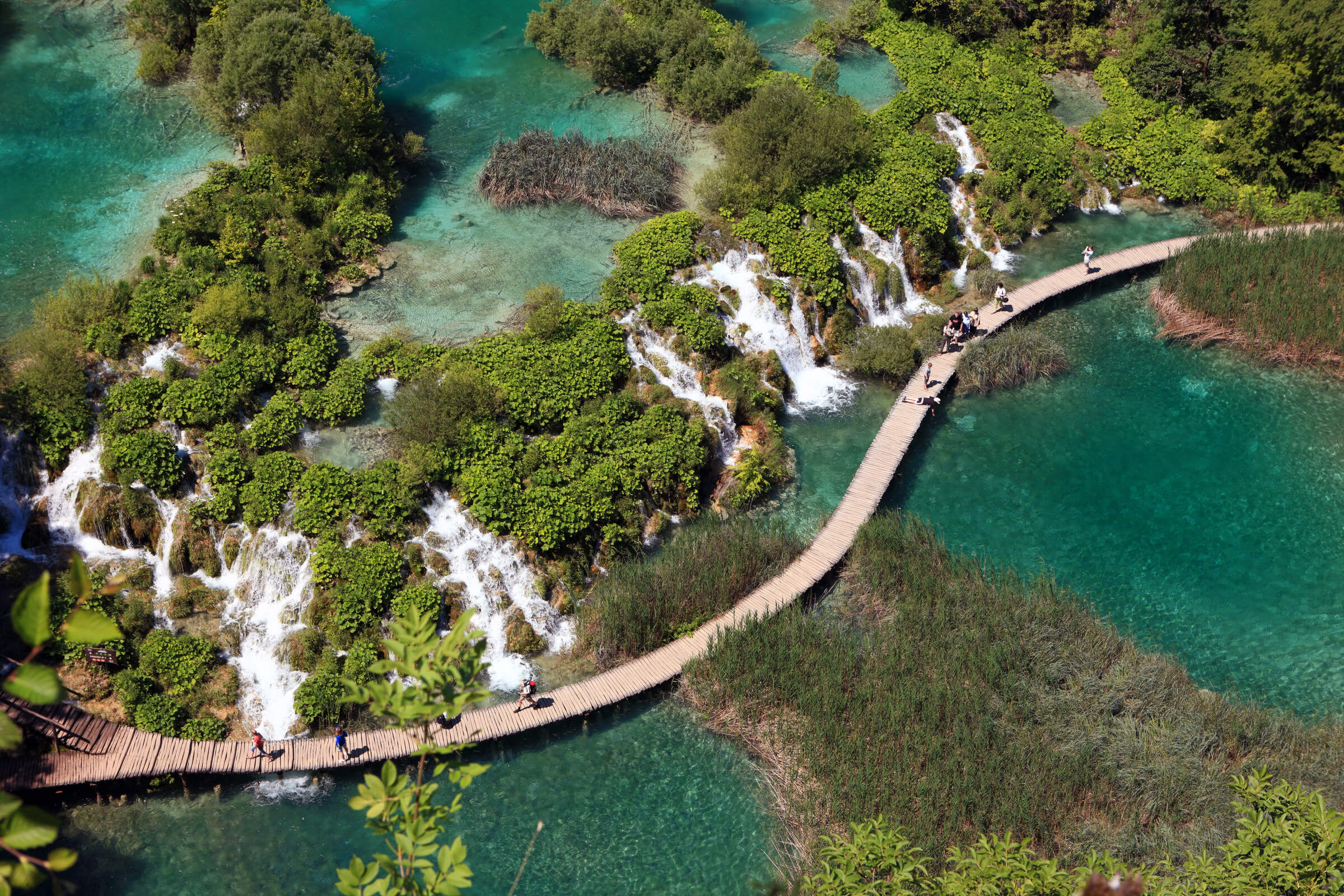 Photo credit: Mario Romulić
Photo credit: Mario Romulić
The Plitvice Lakes National Park is probably the most famous national park in Croatia. Millions of tourists flock to visit this magnificent landscape that is consisted of 16 crystal shades of blue and emerald lakes which are connected by many rivers, streams, caves, and waterfalls and are surrounded by luscious green woodland. This incredible scenery was created by the endless stream of waters that have been flowing over limestones and chalks for thousands of years, until eventually forming natural dams through deposits of travertine barriers. All thanks to nature's wonderful phenomenon, a series of 16 beautiful lakes came to life!
But Croatian folklore, on the other hand, believes that Plitvice Lakes appear magical because it was, indeed, magical. Legend has it that a long time ago, the area of Plitvice only had one source of water - the Black River (Crna Rijeka). Unfortunately, the area was struck with a long-lasting horrible drought which dried out the Black River, and the crops, livestock, and people began dying. In despair, the people prayed and cried all day to the heavens for some rain, but for a very long time, their prayers were left unanswered. They were close to giving up when the Black Queen, who had just left her fairy palace to head to an area near Plitvice, happened to hear their pleas. After witnessing the damage of the drought to the people, the Black Queen said, “I am sad to see that you are suffering!” After that, the winds and thunder started to roar and strong rain came and poured for days and days on end until the Black River overflowed and 13 lakes appeared. People believed that the Black Queen cried for the people's misfortunes and her black and white tears formed the Black River and the White River in Plitvice. Together with the Matica River, they form the first lake and it was named Prošćansko (prošnja = prayer), to commemorate the prayers of the anguished people. For their token of gratitude to the Black Queen, the people of Plitvice built her a castle on the hill above lake Kozjak, where she can admire the splendour of her own creation.
Imotski's Red and Blue Lakes and The Wicked Gavan Family
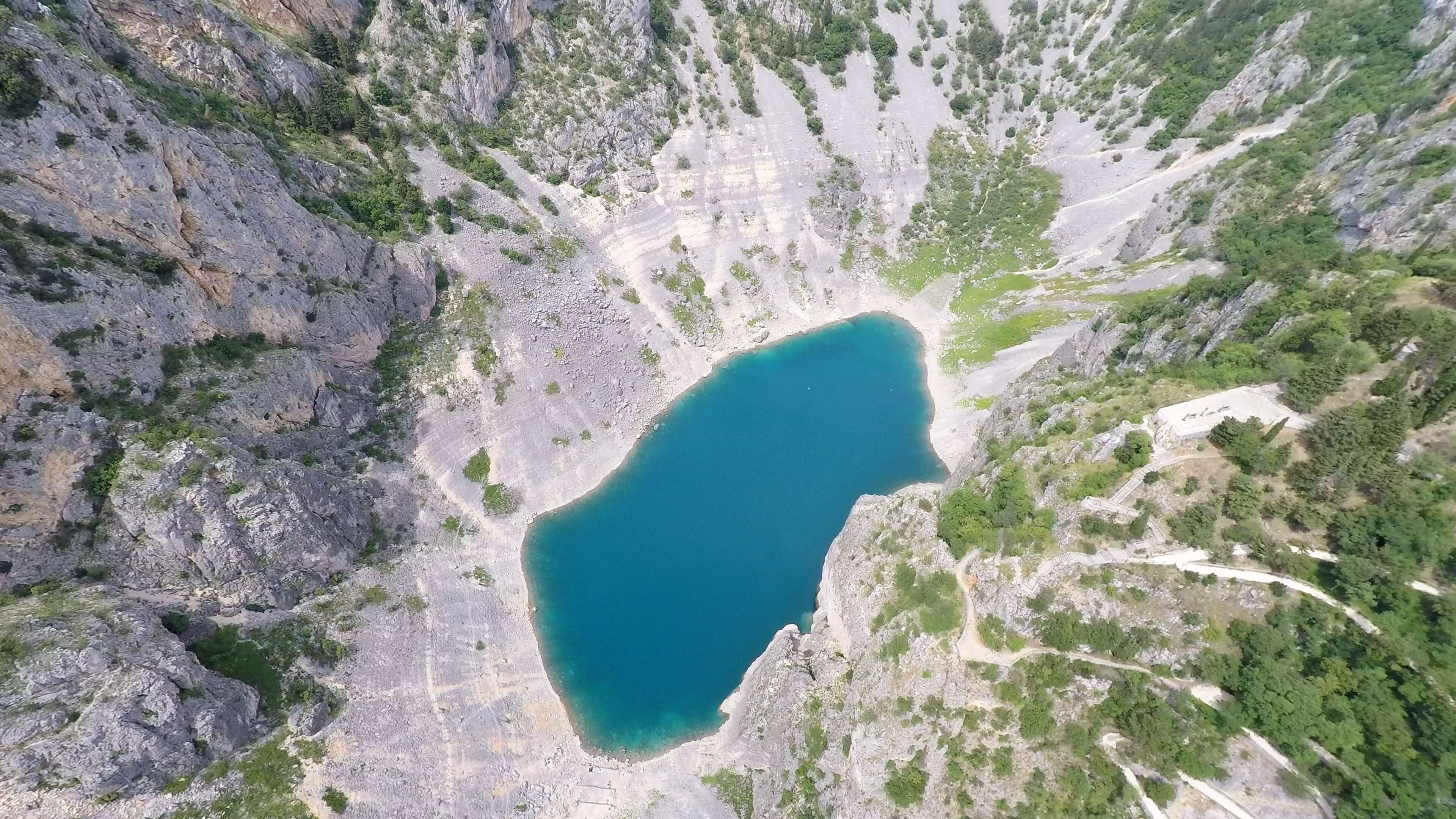 Photo credit: By Yacht Rent from Croatia - modro jezero Croatia, CC BY 2.0, https://commons.wikimedia.org/w/index.php?curid=81974343
Photo credit: By Yacht Rent from Croatia - modro jezero Croatia, CC BY 2.0, https://commons.wikimedia.org/w/index.php?curid=81974343
A small town that is perfect for travellers who wish to steer away from the frenzy of tourists, Imotski is Dalmatia’s hidden gem packed with nature, culture, history, and friendly locals. Unlike the busy coastal cities of Dubrovnik and Split, Imotski possesses a different charm - tucked in the inland region of Dalmatia without the Adriatic Sea, this town, instead, offers an array of unique and breath-taking landscapes to its visitors. Imotski is rigged with incredible karst formations such as hidden caves, sinkholes, karst rivers, lakes, and canyons. The distinctive geographical formations of Imotski inspired countless folk tales including fairies, heroines, and goblins. Perhaps the most famous of these intriguing formations are the Red and Blue Lakes, two magnificent karst lake formations which, according to Croatian folklore, have emerged to swallow the palace and wealth of the wicked Gavan family.
Named after the reddish color of the surrounding cliffs, the Red Lake is a beautiful karst lake and the third largest sinkhole in the world. It can't be reached on foot and without special equipment. Meanwhile, the Blue Lake is easily accessible and is located just beneath the historical Topana Fortress in Imotski. Locals and tourists are welcome to swim in the calm, turquoise blue water of the lake. The stunning and serene blue lake, however, hides a story of the evil Gavan family who used to live in the area of Imotski. According to folklore, Gavan with his wife, Gavanica, and their children, were the wealthiest and most powerful family in Imotski. Nonetheless, the Gavan family was known to be very cruel and vile towards their servants and neighbours and the only thing that mattered to them was their wealth. An angel heard about Gavan’s horrific acts and decided to descend down from heaven to test the Gavan family. The angel disguised as a beggar and knocked on the Gavan's palace door to ask for help. Gavanica opened the door and refused to provide any help to the beggar. The angel then asked Gavanica, “Are you not afraid of God’s punishment?” The arrogant woman replied, “What good can God do for me when I have my Gavan?” It was then that the angel revealed his disguise and punished the Gavan family. It was believed that the ground where the Gavan’s palace stood cracked open and swallowed the Gavans and their entire wealth. The locals still believe that the deep hole, now covered by the Red and Blue Lakes, still contain the palace and wealth of the family and on windy days when the bora wind blows, the screams of Gavan and Gavanica can still be heard around the area of these lakes. The locals also claim that beautiful fairies who live in the Fairy Cave in the Blue Lake have been sighted basking in the beauty of the lake at sunset and dawn. There is a current rumor that no human has ever managed to set foot on the Fairy Cave.
Stories of fairies and foes aside, the Blue Lake transforms into a spectacular football field every few years when it dries up. Many people flock to Imotski to witness these rare and out-of-this-world football matches on Imotski’s mysterious lakebed.
Krka National Park and The Tragic Love Story of Bogdan and Miljeva
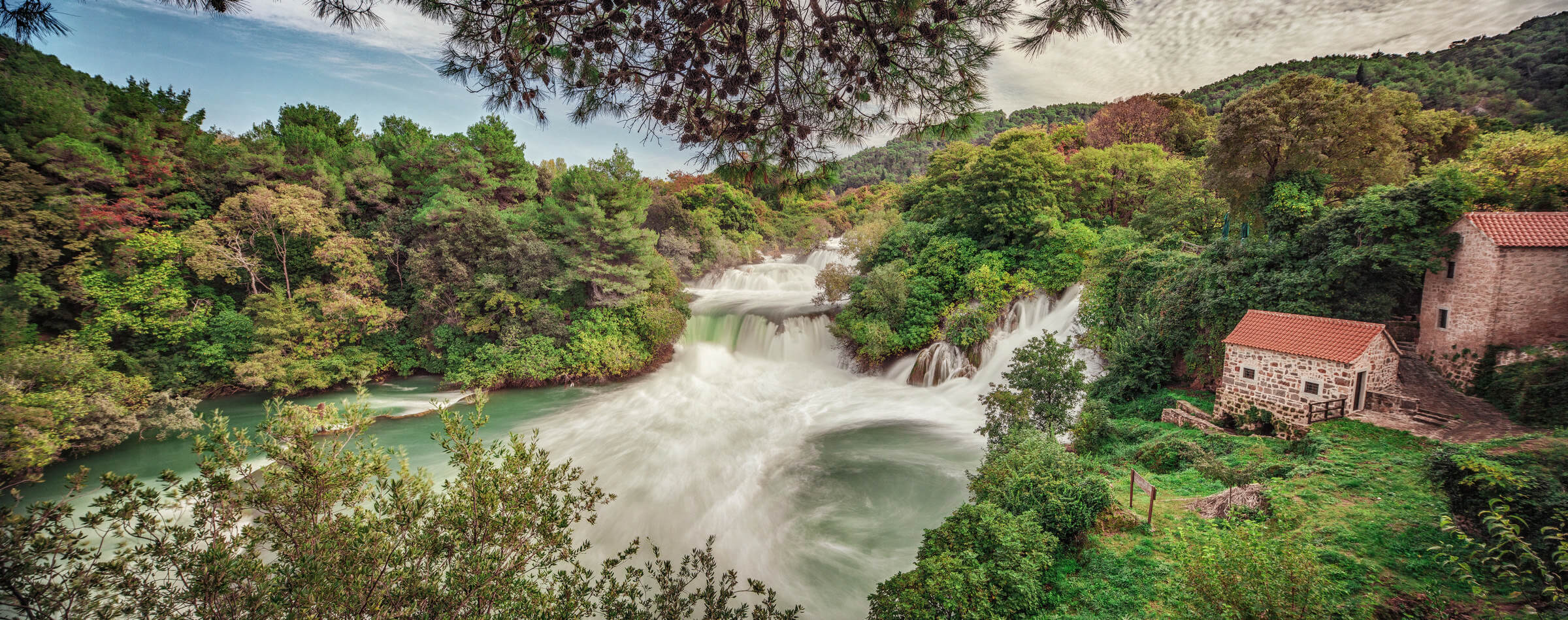 Photo credit: Mario Romulić
Photo credit: Mario Romulić
One of the most visited national parks in Croatia, Krka National Park has it all - the iconic Skradinski Buk waterfall, Neolithic cave, Roman architecture remains, Krka Monastery and so much more! It is also very accessible especially if you are coming from the coastal cities of Split and Šibenik. The park which is filled with dazzling waterfalls, gorges, and the 73km-long Krka river that gushes through a karstic canyon of 200m deep are intertwined by walking paths, hiking trails, and wooden bridges. The park has five main entrances: Skradin, Lozovac, Roški Slap, Krka Monastery, and Burnum, and all are accessible by car. But before becoming Dalmatia’s most famous tourist attraction, Krka National Park is built from the tragic love story of Bogdan and Miljeva.
A long time ago, the mighty Prince Bogoje lived in the area of Krka. In Bogočin, he built a beautiful palace for his son, Bogdan, who was set to marry a lovely noblewoman who lives in the town of Ključ across the river Čikola. That woman’s name was Miljeva and she was the daughter of influential Ban Domagoj and his wife Čika. Bogdan and Miljeva were cherished by the townspeople and on their wedding day, a large gathering of seven bans and twelve county prefects have gathered in Bogočin to witness the union of the beloved couple. The wedding was a success and everyone headed to the palace to celebrate the newlyweds where a tragic fate awaited the couple. During the celebration, a terrifying dragon descended into the party and dragged Princess Miljeva to the bottom of Lake Brljan. Prince Bogdan came to rescue his bride but the beast drew him to the river of Krka as well. This tragedy broke the heart of Prince Bogoje who used up all his wealth to grieve the loss of his son and Miljeva. With his riches, he built Aranđelovac monastery, a place to pray for the souls of the lovers. He also built the towns of Čučevo and Nečven to symbolize the love between Bogdan and Miljeva. In addition, he built two bridges which connect Roški waterfall and river Miljacka. Local folks believed that anyone who wishes to cross the bridges has to shed two tears to pay homage to the tragic fate of Bogdan and Miljeva's love. In the end, Prince Bogoje tore down the Bogočin palace and set off from this grief-stricken town into the unknown. Meanwhile, Miljeva’s mother, Čika, secluded herself to pray for the late lovers in a tower she built in Ključ.
Because of this tragic love story, Bogočin is known by the locals as a “fairy town”, the river near Ključ is named Čikola and the area between Bogočin and Ključ is called Miljevci.
For more on Croatia's top travel destinations, follow Total Croatia.
For more on travel, follow TCN's dedicated page.
For more about Croatia, CLICK HERE.


